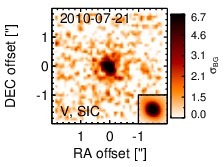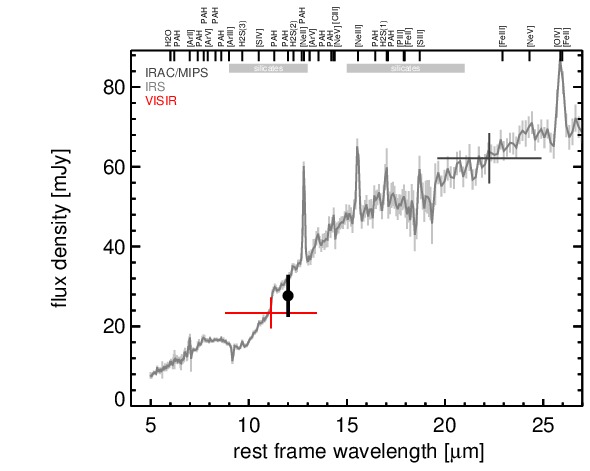Sasmirala Individual Information for PKS 1814-63
Description
PKS 1814-63/LEDA 329451 is a radio-loud disturbed edge-on lenticular galaxy at a redshift of z = 0.0627 (D ~ 302 Mpc) with a Sy 2 nucleus [veron-cetty_catalogue_2010] and a dust lane crossing the galaxy’s centre [ramos_almeida_optical_2011]. The nucleus is extended in the north-south direction in subarcsecond-resolution radio observations and has a steep radio spectrum (e.g. [tzioumis_sample_2002]). The first MIR detection of this object was achieved with Spitzer/MIPS where it appears nearly unresolved [dicken_origin_2008]. Our nuclear MIPS 24 μm photometry is consistent with the latter work. The Spitzer/IRS LR staring-mode spectrum exhibits silicate absorption, weak PAH features, and a shallow red spectral slope in νFν-space. The arcsecond-scale MIR SED might, thus, be affected by star-formation emission. PKS 1814-63 was observed with VISIR in the broad SIC filter in 2010 (unpublished, to our knowledge), and a compact nucleus is weakly detected. It appears to be elongated in the north-south direction (FWHM ~ 0.56arcsec ~ 0.7 kpc; PA~ 26∘). However, the current MIR data are insufficient to reach any robust conclusion about the nuclear extension at subarcsecond scales in the MIR. The nuclear VISIR photometry is consistent with the Spitzer spectrophotometry.
- [dicken_origin_2008] D. Dicken, C. Tadhunter, R. Morganti, C. Buchanan, T. Oosterloo, and D. Axon. The origin of the infrared emission in radio galaxies. i. new mid- to far-infrared and radio observations of the 2 jy sample . ApJ , 678 pp. 712–728, May 2008.
- [ramos_almeida_optical_2011] C. Ramos Almeida, C. N. Tadhunter, K. J. Inskip, R. Morganti, J. Holt, and D. Dicken. The optical morphologies of the 2 jy sample of radio galaxies: evidence for galaxy interactions . MNRAS , 410 pp. 1550–1576, January 2011.
- [tzioumis_sample_2002] A. Tzioumis, E. King, R. Morganti, D. Dallacasa, C. Tadhunter, C. Fanti, J. Reynolds, D. Jauncey, R. Preston, P. McCulloch, S. Tingay, P. Edwards, M. Costa, D. Jones, J. Lovell, R. Clay, D. Meier, D. Murphy, R. Gough, R. Ferris, G. White, and P. Jones. A sample of southern compact steep spectrum radio sources: The VLBI observations . A&A , 392 pp. 841–850, September 2002.
- [veron-cetty_catalogue_2010] M.-P. Véron-Cetty and P. Véron. A catalogue of quasars and active nuclei: 13th edition . A&A , 518 pp. 10, July 2010.
Images

Optical image (DSS, red filter). Displayed are the central 4 arcmin with North being up and East to the left. The colour scaling is linear with white corresponding to the median background (BG) and black to the 0.01% pixels with the highest intensity.

Spitzer MIR images. Displayed are the inner 40 arcsec with North being up and East to the left. The colour scaling is logarithmic with white corresponding to median BG and black to the 0.1% pixels with the highest intensity. The label in the bottom left states instrument and central wavelength of the filter in micron (I: IRAC, M: MIPS).

Subarcsecond-resolution MIR images sorted by increasing filter central wavelength. Displayed are the inner 4 arcsec with North being up and East to the left. The colour scaling is logarithmic with white corresponding to median BG and black to the 75% of the highest intensity of all images in units of sig_bg. The inset image (where present; either bottom or top right) shows the central arcsecond of the PSF from the calibrator star, scaled to match the science target. The labels in the bottom left state instrument and filter names (C: COMICS, M: Michelle, T: T-ReCS, V: VISIR).
SEDs


MIR SED. The description of the symbols in all the SED plots (where present) is the following: Grey crosses and solid lines mark the Spitzer/IRAC, MIPS and IRS data. The colour coding of the other symbols is as follows: green for COMICS, magenta for Michelle, blue for T-ReCS and red for VISIR data. Darker-coloured solid lines mark spectra of the corresponding instrument. The black filled circles mark the nuclear 12 and 18 micron continuum emission estimate from the data (where present). The ticks on the top axis mark positions of common MIR emission lines, while the light grey horizontal bars mark wavelength ranges affected by the silicate 10 and 18 micron features.